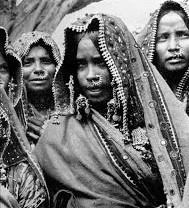 MAHATMA GANDHI
is revered in wax at the All-India Congress at Ramgarh
MAHATMA GANDHI
is revered in wax at the All-India Congress at Ramgarh
|
|

THE CONQUERORS THROW DICE
FOR RICHEST, OLDEST PRIZE OF ALL
India itself, the legendary treasure house, the ancient heart of the world, the tiara of the British Empire, was last week in peril.
Japs were in Burma, headed west. And what was to become of 300,000,000 Indians was no longer entirely in the hands of the India Office in London.
The destiny of India had been thrown out once more as a stake of war.
That was nothing new. Five thousand years ago there were great civilized empires in India. Conquerors roared in through the Northwest
Frontier, Aryans, Scythians and Macedonians under Alexander the Great. First and last there were six great Moslem invasions. The result is that
India has 80,000,000 Moslems and 250,000,000 Hindus. But most of the fight is in the 80,000,000, while most of the talk is in the Hindus, whose
leaders are the ones who demand independence for India. Independence, under one name or another, may well be the belated price Britain has to pay
Gandhi, Nehru & Co. to get their India really to fight.
The British, India's last invaders 200 years ago, have not been cruel to that country which is as big as European Russia. They have saved
it from war and famine and raised its substinence level well above that of China. But LIFE's Photographer Wallace Kirkland saw not one steel plowshare,
scythe, harvester, reaper or tractor in a land where 90% of the people are farmers. British paternalism has filled India with far more rage than
gratitude, since Queen Victoria became Empress of India in 1877.
The traditional wealth of India is chiefly in such marvels as the Jain Temple at Calcutta shown below.
(Notice the Jain religionist, head in hands, sitting on the steps above the pool.)

But the true treasure of India is not in its glittering array of temples and mosques and palaces. It is not even
India's second-rate mineral deposits or third-rate industrial plant. What the onrushing Japs want from India is a treasure surpassing
all these. They are ravenous for India's labor supply of 300,000,000 people, 20% of the working hands in all the world. And this vast
labor reservoir is overwhelmingly docile, intelligent, skilled, used to obedience and small pay. The ruler for whom it works and from whom
it buys has always heretofore been the most powerful ruler in the world.
 RULERS OF BRITISH INDIA,
gathered around Viceroy Lord Linlithgow (front center), are (first row): Bhopal's Nawab, Gwalior's Maharaja, Bikaner's
Maharajadhiraja, Nawanger's Maharaja who is Chancellor of the Chamber of Princes, Viceroy, Bahawalpur's Prime Minister, Madra's ex-Officiating
Governor, Dharbhanga's Maharajadhiraj, Punjab assemblywoman and reformer; (second row), Chhztzri's Nawah, Cooch Behar's Maharaja,
Rampur's Nawah, Patiala's Maharaja, Jodhpur's Maharaja, Bombat Parsi, Khallikote's Raja, Punjab assemblyman, leader of the Madras opposition,
and Berar delegate to Chamber of Princes.
Last row includes (center) two of Viceroy's secretaries.
These 30 mean and one woman constitute India's National Defense Council. They rule British India's 280,000,000 people, plus some of the 562
Indian states of the semi-independent princes who have backed Britain to the limit.
RULERS OF BRITISH INDIA,
gathered around Viceroy Lord Linlithgow (front center), are (first row): Bhopal's Nawab, Gwalior's Maharaja, Bikaner's
Maharajadhiraja, Nawanger's Maharaja who is Chancellor of the Chamber of Princes, Viceroy, Bahawalpur's Prime Minister, Madra's ex-Officiating
Governor, Dharbhanga's Maharajadhiraj, Punjab assemblywoman and reformer; (second row), Chhztzri's Nawah, Cooch Behar's Maharaja,
Rampur's Nawah, Patiala's Maharaja, Jodhpur's Maharaja, Bombat Parsi, Khallikote's Raja, Punjab assemblyman, leader of the Madras opposition,
and Berar delegate to Chamber of Princes.
Last row includes (center) two of Viceroy's secretaries.
These 30 mean and one woman constitute India's National Defense Council. They rule British India's 280,000,000 people, plus some of the 562
Indian states of the semi-independent princes who have backed Britain to the limit.
 BRITISH PERMIT
the Moslem Pathans of the Northwest Frontier to make their own crude rifles.
Lower pipe is barrel, being ground to size by steel abrasive insert.
BRITISH PERMIT
the Moslem Pathans of the Northwest Frontier to make their own crude rifles.
Lower pipe is barrel, being ground to size by steel abrasive insert.
|
 IN THE SQUALOR
of the south, poor Indians fluff up moonj fiber (left), card it (Center) by revolving it on spike stuck in a cup, and then spin it into cloth (Right).
IN THE SQUALOR
of the south, poor Indians fluff up moonj fiber (left), card it (Center) by revolving it on spike stuck in a cup, and then spin it into cloth (Right).
|
 EUROPEANS' LAUNDRY
is always washed by men at the Dhobe Ghat at Delhi, downstream from the ghat where the ashes of the dead are thrown into the Jumna River.
Men do the washing, though women may sometimes spread out the clothes.
Indian women rarely come in contact with Europeans as servants.
The big tubs are for starching and bluing.
EUROPEANS' LAUNDRY
is always washed by men at the Dhobe Ghat at Delhi, downstream from the ghat where the ashes of the dead are thrown into the Jumna River.
Men do the washing, though women may sometimes spread out the clothes.
Indian women rarely come in contact with Europeans as servants.
The big tubs are for starching and bluing.
|
 MANURE CAKES
are the poor man's fuel of India. The dung of the animals is scraped up by women and children, formed into cakes and dried in the sun.
Usually this is work for the Untouchables or "depressed classes," descendants of India's ancient Dravidians not taken into the caste system.
Whole villages make a business of making and selling dung cakes.
MANURE CAKES
are the poor man's fuel of India. The dung of the animals is scraped up by women and children, formed into cakes and dried in the sun.
Usually this is work for the Untouchables or "depressed classes," descendants of India's ancient Dravidians not taken into the caste system.
Whole villages make a business of making and selling dung cakes.
|
|
IRRIGATION
of the dry Indian plain is done by a camel tamping in a circle, revolving a gear wheel (background) which in turn revolves bucket wheel
(left). By building a vast network of canals and damns, British ended famines in India, raised total of irrigated land from 4,500,000
acres in 1879 to 32,000,000 today. Rich Indians who want to be honored now bequeath a well to their village.
|
ITS TREASURES
ARE MANY AND
BLOODSTAINED
|
The bloody and gorgeous history of India has never yet been written and will not be written for some time.
There has never been, in fact, a single India any more than there has ever been a single Europe.
Countless peoples and cultures have fought here for their lives. New conquerors raged interminably out of the north
and west, exterminated nations and cities, and themselves vanished into the boiling pool of this humanity.
Few of their stories were written down, and when they were the next conquerors destroyed the record.
Diggers in the west and north and east are today discovering under the ground the glories of totally forgotten
civilizations that rivals Egypt and Sumeria 3,000 years ago. Above ground, some more recent magnificences remain.
Two are shown on this page, one from the east and one from the north country of the Rajputs.
There are thousands more, all different from one another. They are as often the work of slave peoples as of
conquerors. All have a quality of strangeness, sometimes morbid but always incomprehensible to the West.
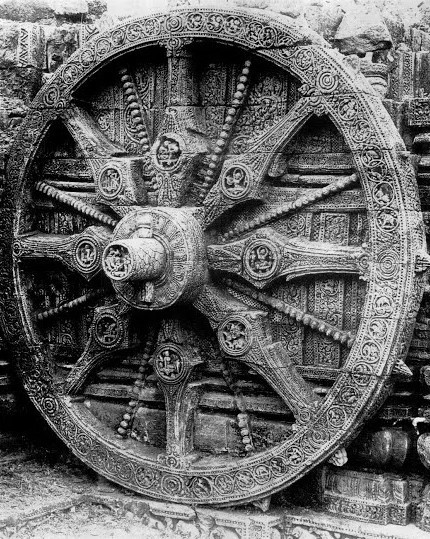 THE WHEEL
is one of the first crucial signs of civilization.
It first appeared in western India before 3000 B.C.
This carved stone wheel of the Brahman sun god's chariot on the Black Pagoda was built at Kanarak in Orissa 700 years ago, when a Moslem conqueror
from Persia had overrun all the Indian plain.
Nearby is the famous temple of Jaganath, or Juggernaut, at Puri.
The 120-ft. tower of Kanarak has been called "the most richly ornamental building in the whole world."
It is covered with antic human figures, horses, elephants and lions.
THE WHEEL
is one of the first crucial signs of civilization.
It first appeared in western India before 3000 B.C.
This carved stone wheel of the Brahman sun god's chariot on the Black Pagoda was built at Kanarak in Orissa 700 years ago, when a Moslem conqueror
from Persia had overrun all the Indian plain.
Nearby is the famous temple of Jaganath, or Juggernaut, at Puri.
The 120-ft. tower of Kanarak has been called "the most richly ornamental building in the whole world."
It is covered with antic human figures, horses, elephants and lions.
|
 ASTRONOMY
got this imposing monument near Delhi in the north-central plain of the fighting Hindu Rajputs.
The two perforated walled circles are to mark the rise and decline of the stars.
The photograph is taken from an immense sundial whose upright is 56 ft. high.
All this was built by the great mathematician and astronomer, Maharaja Jai Singh of Jaipur, in about 1725.
These Rajput Hindu princes were so afraid of their Moslem overlords that they covered their most
glorious wall carvings with stucco, to avoid shaming Moslem art.
ASTRONOMY
got this imposing monument near Delhi in the north-central plain of the fighting Hindu Rajputs.
The two perforated walled circles are to mark the rise and decline of the stars.
The photograph is taken from an immense sundial whose upright is 56 ft. high.
All this was built by the great mathematician and astronomer, Maharaja Jai Singh of Jaipur, in about 1725.
These Rajput Hindu princes were so afraid of their Moslem overlords that they covered their most
glorious wall carvings with stucco, to avoid shaming Moslem art.
|
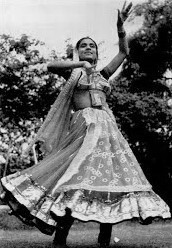 OFFICIAL'S DAUGHTER
in Delhi is Maya Mani Chatterji, who goes through the artificial hand-posturing of the dance of the cowherds' daughters (Gopis) to
seduce Lord Krishna, one of the Hindu gods. Maya has danced in London. This is very civilized, upper-class Indian dancing.
OFFICIAL'S DAUGHTER
in Delhi is Maya Mani Chatterji, who goes through the artificial hand-posturing of the dance of the cowherds' daughters (Gopis) to
seduce Lord Krishna, one of the Hindu gods. Maya has danced in London. This is very civilized, upper-class Indian dancing.
|
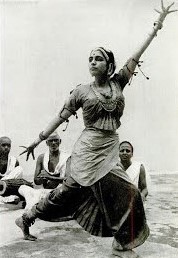 THEOSOPHIST'S WIFE
is Rukmini Devi, 33, who is trying to revive the South India dance of Bharata-Natya, which had become d class because temple prostitutes
used to dance it. Dance represents very spiritual emotions of the gods. She thinks Bharata-Natya will revive India.
THEOSOPHIST'S WIFE
is Rukmini Devi, 33, who is trying to revive the South India dance of Bharata-Natya, which had become d class because temple prostitutes
used to dance it. Dance represents very spiritual emotions of the gods. She thinks Bharata-Natya will revive India.
|
|
CAMP FOLLOWERS
of the old invading armies were supposedly the ancestors of these Lombani women. They are laboring women who carry head loads of dirt in road
construction, but they always wear these bone, ivory and shell bangles. They are the gypsies of India.
|
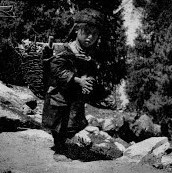 MOUNTAIN GIRL
with eyes like a wood mouse carries firewood in the northern valley of Kashmir.
As in most of India, this child began to work hard as soon as she could toddle.
The next big event in her life will be to be married off in another few years.
Note deodars in the background.
MOUNTAIN GIRL
with eyes like a wood mouse carries firewood in the northern valley of Kashmir.
As in most of India, this child began to work hard as soon as she could toddle.
The next big event in her life will be to be married off in another few years.
Note deodars in the background.
|
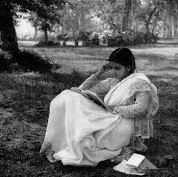 GIRL UNDERGRADUATE
reads on the campus of the Sacred Heart Convent at Lahore in the central Punjab.
She is upper-class and wears a native Indian sari.
In all India, there are 31 arts colleges for women, eight training colleges and one medical college.
But co-education is common.
GIRL UNDERGRADUATE
reads on the campus of the Sacred Heart Convent at Lahore in the central Punjab.
She is upper-class and wears a native Indian sari.
In all India, there are 31 arts colleges for women, eight training colleges and one medical college.
But co-education is common.
|
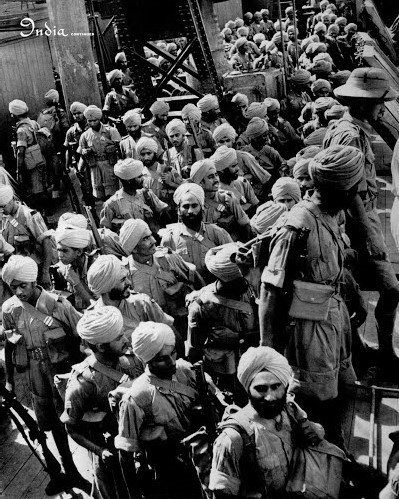 AN INDIAN ARMY
fought and lost at Singapore. The bearded Sikhs shown here were among the approximately 50,000 Indian troops who participated in that campaign.
Among the toughest fighters from India, they worship a sacred book and hold to five kakkars: uncut hair, short drawers, iron bangle, wooden
comb and short sword. Every man carries the proud surname Singh, meaning lion. But Hindus are a minority in the Indian Army, its great backlog of
fighting men being composed of Moslems from the Punjab and the Northwest Frontier Province.
AN INDIAN ARMY
fought and lost at Singapore. The bearded Sikhs shown here were among the approximately 50,000 Indian troops who participated in that campaign.
Among the toughest fighters from India, they worship a sacred book and hold to five kakkars: uncut hair, short drawers, iron bangle, wooden
comb and short sword. Every man carries the proud surname Singh, meaning lion. But Hindus are a minority in the Indian Army, its great backlog of
fighting men being composed of Moslems from the Punjab and the Northwest Frontier Province.
|
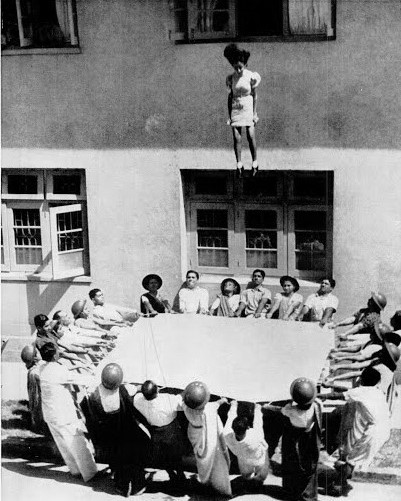 AIR-RAID PRECAUTIONS
in Bombay, barely out of range of Jap Army bombers, induce this Indian girl to leap into a blanket held by fellow wardens, male and female.
Probably no country has been caught so short by the threat of war as India, which had felt that any possible war cloud could only blow up from
the west, whence all India's invasions have come. Instead, it now finds Japan pounding on the eastern gates of Burma.
The aroused community spirit of the Indians has so far taken such forms as that above, which somehow suggests an Indian fakir's rope trick.
AIR-RAID PRECAUTIONS
in Bombay, barely out of range of Jap Army bombers, induce this Indian girl to leap into a blanket held by fellow wardens, male and female.
Probably no country has been caught so short by the threat of war as India, which had felt that any possible war cloud could only blow up from
the west, whence all India's invasions have come. Instead, it now finds Japan pounding on the eastern gates of Burma.
The aroused community spirit of the Indians has so far taken such forms as that above, which somehow suggests an Indian fakir's rope trick.
|


Adapted by Carl W. Weidenburner
from the March 16, 1942 issue of LIFE.
Portions copyright 1942 Time, Inc.
FOR PRIVATE NON-COMMERCIAL HISTORICAL REFERENCE ONLY
TOP OF PAGE
ABOUT THIS PAGE
MORE CBI FROM LIFE MAGAZINE
CLOSE THIS WINDOW
|


 RULERS OF BRITISH INDIA,
gathered around Viceroy Lord Linlithgow (front center), are (first row): Bhopal's Nawab, Gwalior's Maharaja, Bikaner's
Maharajadhiraja, Nawanger's Maharaja who is Chancellor of the Chamber of Princes, Viceroy, Bahawalpur's Prime Minister, Madra's ex-Officiating
Governor, Dharbhanga's Maharajadhiraj, Punjab assemblywoman and reformer; (second row), Chhztzri's Nawah, Cooch Behar's Maharaja,
Rampur's Nawah, Patiala's Maharaja, Jodhpur's Maharaja, Bombat Parsi, Khallikote's Raja, Punjab assemblyman, leader of the Madras opposition,
and Berar delegate to Chamber of Princes.
Last row includes (center) two of Viceroy's secretaries.
These 30 mean and one woman constitute India's National Defense Council. They rule British India's 280,000,000 people, plus some of the 562
Indian states of the semi-independent princes who have backed Britain to the limit.
RULERS OF BRITISH INDIA,
gathered around Viceroy Lord Linlithgow (front center), are (first row): Bhopal's Nawab, Gwalior's Maharaja, Bikaner's
Maharajadhiraja, Nawanger's Maharaja who is Chancellor of the Chamber of Princes, Viceroy, Bahawalpur's Prime Minister, Madra's ex-Officiating
Governor, Dharbhanga's Maharajadhiraj, Punjab assemblywoman and reformer; (second row), Chhztzri's Nawah, Cooch Behar's Maharaja,
Rampur's Nawah, Patiala's Maharaja, Jodhpur's Maharaja, Bombat Parsi, Khallikote's Raja, Punjab assemblyman, leader of the Madras opposition,
and Berar delegate to Chamber of Princes.
Last row includes (center) two of Viceroy's secretaries.
These 30 mean and one woman constitute India's National Defense Council. They rule British India's 280,000,000 people, plus some of the 562
Indian states of the semi-independent princes who have backed Britain to the limit.
 BRITISH PERMIT
the Moslem Pathans of the Northwest Frontier to make their own crude rifles.
Lower pipe is barrel, being ground to size by steel abrasive insert.
BRITISH PERMIT
the Moslem Pathans of the Northwest Frontier to make their own crude rifles.
Lower pipe is barrel, being ground to size by steel abrasive insert.
 IN THE SQUALOR
of the south, poor Indians fluff up moonj fiber (left), card it (Center) by revolving it on spike stuck in a cup, and then spin it into cloth (Right).
IN THE SQUALOR
of the south, poor Indians fluff up moonj fiber (left), card it (Center) by revolving it on spike stuck in a cup, and then spin it into cloth (Right).
 EUROPEANS' LAUNDRY
is always washed by men at the Dhobe Ghat at Delhi, downstream from the ghat where the ashes of the dead are thrown into the Jumna River.
Men do the washing, though women may sometimes spread out the clothes.
Indian women rarely come in contact with Europeans as servants.
The big tubs are for starching and bluing.
EUROPEANS' LAUNDRY
is always washed by men at the Dhobe Ghat at Delhi, downstream from the ghat where the ashes of the dead are thrown into the Jumna River.
Men do the washing, though women may sometimes spread out the clothes.
Indian women rarely come in contact with Europeans as servants.
The big tubs are for starching and bluing.
 MANURE CAKES
are the poor man's fuel of India. The dung of the animals is scraped up by women and children, formed into cakes and dried in the sun.
Usually this is work for the Untouchables or "depressed classes," descendants of India's ancient Dravidians not taken into the caste system.
Whole villages make a business of making and selling dung cakes.
MANURE CAKES
are the poor man's fuel of India. The dung of the animals is scraped up by women and children, formed into cakes and dried in the sun.
Usually this is work for the Untouchables or "depressed classes," descendants of India's ancient Dravidians not taken into the caste system.
Whole villages make a business of making and selling dung cakes.
 THE WHEEL
is one of the first crucial signs of civilization.
It first appeared in western India before 3000 B.C.
This carved stone wheel of the Brahman sun god's chariot on the Black Pagoda was built at Kanarak in Orissa 700 years ago, when a Moslem conqueror
from Persia had overrun all the Indian plain.
Nearby is the famous temple of Jaganath, or Juggernaut, at Puri.
The 120-ft. tower of Kanarak has been called "the most richly ornamental building in the whole world."
It is covered with antic human figures, horses, elephants and lions.
THE WHEEL
is one of the first crucial signs of civilization.
It first appeared in western India before 3000 B.C.
This carved stone wheel of the Brahman sun god's chariot on the Black Pagoda was built at Kanarak in Orissa 700 years ago, when a Moslem conqueror
from Persia had overrun all the Indian plain.
Nearby is the famous temple of Jaganath, or Juggernaut, at Puri.
The 120-ft. tower of Kanarak has been called "the most richly ornamental building in the whole world."
It is covered with antic human figures, horses, elephants and lions.
 ASTRONOMY
got this imposing monument near Delhi in the north-central plain of the fighting Hindu Rajputs.
The two perforated walled circles are to mark the rise and decline of the stars.
The photograph is taken from an immense sundial whose upright is 56 ft. high.
All this was built by the great mathematician and astronomer, Maharaja Jai Singh of Jaipur, in about 1725.
These Rajput Hindu princes were so afraid of their Moslem overlords that they covered their most
glorious wall carvings with stucco, to avoid shaming Moslem art.
ASTRONOMY
got this imposing monument near Delhi in the north-central plain of the fighting Hindu Rajputs.
The two perforated walled circles are to mark the rise and decline of the stars.
The photograph is taken from an immense sundial whose upright is 56 ft. high.
All this was built by the great mathematician and astronomer, Maharaja Jai Singh of Jaipur, in about 1725.
These Rajput Hindu princes were so afraid of their Moslem overlords that they covered their most
glorious wall carvings with stucco, to avoid shaming Moslem art.
 OFFICIAL'S DAUGHTER
in Delhi is Maya Mani Chatterji, who goes through the artificial hand-posturing of the dance of the cowherds' daughters (Gopis) to
seduce Lord Krishna, one of the Hindu gods. Maya has danced in London. This is very civilized, upper-class Indian dancing.
OFFICIAL'S DAUGHTER
in Delhi is Maya Mani Chatterji, who goes through the artificial hand-posturing of the dance of the cowherds' daughters (Gopis) to
seduce Lord Krishna, one of the Hindu gods. Maya has danced in London. This is very civilized, upper-class Indian dancing.
 THEOSOPHIST'S WIFE
is Rukmini Devi, 33, who is trying to revive the South India dance of Bharata-Natya, which had become d class because temple prostitutes
used to dance it. Dance represents very spiritual emotions of the gods. She thinks Bharata-Natya will revive India.
THEOSOPHIST'S WIFE
is Rukmini Devi, 33, who is trying to revive the South India dance of Bharata-Natya, which had become d class because temple prostitutes
used to dance it. Dance represents very spiritual emotions of the gods. She thinks Bharata-Natya will revive India.
 MOUNTAIN GIRL
with eyes like a wood mouse carries firewood in the northern valley of Kashmir.
As in most of India, this child began to work hard as soon as she could toddle.
The next big event in her life will be to be married off in another few years.
Note deodars in the background.
MOUNTAIN GIRL
with eyes like a wood mouse carries firewood in the northern valley of Kashmir.
As in most of India, this child began to work hard as soon as she could toddle.
The next big event in her life will be to be married off in another few years.
Note deodars in the background.
 GIRL UNDERGRADUATE
reads on the campus of the Sacred Heart Convent at Lahore in the central Punjab.
She is upper-class and wears a native Indian sari.
In all India, there are 31 arts colleges for women, eight training colleges and one medical college.
But co-education is common.
GIRL UNDERGRADUATE
reads on the campus of the Sacred Heart Convent at Lahore in the central Punjab.
She is upper-class and wears a native Indian sari.
In all India, there are 31 arts colleges for women, eight training colleges and one medical college.
But co-education is common.
 AN INDIAN ARMY
fought and lost at Singapore. The bearded Sikhs shown here were among the approximately 50,000 Indian troops who participated in that campaign.
Among the toughest fighters from India, they worship a sacred book and hold to five kakkars: uncut hair, short drawers, iron bangle, wooden
comb and short sword. Every man carries the proud surname Singh, meaning lion. But Hindus are a minority in the Indian Army, its great backlog of
fighting men being composed of Moslems from the Punjab and the Northwest Frontier Province.
AN INDIAN ARMY
fought and lost at Singapore. The bearded Sikhs shown here were among the approximately 50,000 Indian troops who participated in that campaign.
Among the toughest fighters from India, they worship a sacred book and hold to five kakkars: uncut hair, short drawers, iron bangle, wooden
comb and short sword. Every man carries the proud surname Singh, meaning lion. But Hindus are a minority in the Indian Army, its great backlog of
fighting men being composed of Moslems from the Punjab and the Northwest Frontier Province.
 AIR-RAID PRECAUTIONS
in Bombay, barely out of range of Jap Army bombers, induce this Indian girl to leap into a blanket held by fellow wardens, male and female.
Probably no country has been caught so short by the threat of war as India, which had felt that any possible war cloud could only blow up from
the west, whence all India's invasions have come. Instead, it now finds Japan pounding on the eastern gates of Burma.
The aroused community spirit of the Indians has so far taken such forms as that above, which somehow suggests an Indian fakir's rope trick.
AIR-RAID PRECAUTIONS
in Bombay, barely out of range of Jap Army bombers, induce this Indian girl to leap into a blanket held by fellow wardens, male and female.
Probably no country has been caught so short by the threat of war as India, which had felt that any possible war cloud could only blow up from
the west, whence all India's invasions have come. Instead, it now finds Japan pounding on the eastern gates of Burma.
The aroused community spirit of the Indians has so far taken such forms as that above, which somehow suggests an Indian fakir's rope trick.


 MAHATMA GANDHI
is revered in wax at the All-India Congress at Ramgarh
MAHATMA GANDHI
is revered in wax at the All-India Congress at Ramgarh



